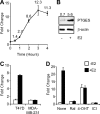Synergistic up-regulation of prostaglandin E synthase expression in breast cancer cells by 17beta-estradiol and proinflammatory cytokines
- PMID: 18703630
- PMCID: PMC6285349
- DOI: 10.1210/en.2008-0352
Synergistic up-regulation of prostaglandin E synthase expression in breast cancer cells by 17beta-estradiol and proinflammatory cytokines
Abstract
Inflammatory mediators, such as cytokines and prostaglandins, play a fundamental role in estrogen-dependent breast cancer through their ability to up-regulate aromatase expression and subsequent local production of estrogens in the breast. To study the link between estrogens and inflammation further, we examined the regulation of prostaglandin E synthase (PTGES), a key enzyme in the production of prostaglandin E2. We found that 17beta-estradiol (E2) rapidly and robustly up-regulates PTGES mRNA and protein levels in estrogen receptor (ER)-positive breast cancer cells through ER recruitment to an essential estrogen response element located in the 5' flanking region of the PTGES gene. PTGES is also up-regulated by the proinflammatory cytokines TNFalpha or IL-1beta. Surprisingly, the combination of E2 and cytokines leads to a synergistic up-regulation of PTGES in an ER and nuclear factor-kappaB (NFkappaB)-dependent manner. This is in contrast to the mutual transrepression between ER and NFkappaB that has been well characterized in other cell types. Furthermore, we found enhanced recruitment of ERalpha as well as the NFkappaB family member, p65, to the PTGES estrogen response element by the combination of E2 and TNFalpha compared with either E2 or TNFalpha alone. The synergistic up-regulation of PTGES may result in enhanced prostaglandin E2 production, which in turn may further enhance aromatase expression and production of local estrogens. Our findings suggest that a finely tuned positive feedback mechanism between estrogens and inflammatory factors may exist in the breast and contribute to hormone-dependent breast cancer growth and progression.
Figures







Similar articles
-
Proinflammatory cytokines enhance estrogen-dependent expression of the multidrug transporter gene ABCG2 through estrogen receptor and NF{kappa}B cooperativity at adjacent response elements.J Biol Chem. 2010 Oct 8;285(41):31100-6. doi: 10.1074/jbc.M110.155309. Epub 2010 Aug 12. J Biol Chem. 2010. PMID: 20705611 Free PMC article.
-
Nuclear factor-kappa B regulates inducible prostaglandin E synthase expression in human amnion mesenchymal cells.Biol Reprod. 2008 Jan;78(1):68-76. doi: 10.1095/biolreprod.107.061663. Epub 2007 Oct 10. Biol Reprod. 2008. PMID: 17928629
-
Prostaglandins induce early growth response 1 transcription factor mediated microsomal prostaglandin E2 synthase up-regulation for colorectal cancer progression.Oncotarget. 2015 Nov 24;6(37):39941-59. doi: 10.18632/oncotarget.5402. Oncotarget. 2015. PMID: 26498686 Free PMC article.
-
Signal pathways involved in the regulation of prostaglandin E synthase-1 in human gingival fibroblasts.Cell Signal. 2006 Dec;18(12):2131-42. doi: 10.1016/j.cellsig.2006.04.003. Cell Signal. 2006. PMID: 16766159
-
Suppression of ligand-dependent estrogen receptor activity by bone-resorbing cytokines in human osteoblasts.Endocrinology. 1999 Jun;140(6):2439-51. doi: 10.1210/endo.140.6.6612. Endocrinology. 1999. PMID: 10342828
Cited by
-
Proinflammatory cytokines enhance estrogen-dependent expression of the multidrug transporter gene ABCG2 through estrogen receptor and NF{kappa}B cooperativity at adjacent response elements.J Biol Chem. 2010 Oct 8;285(41):31100-6. doi: 10.1074/jbc.M110.155309. Epub 2010 Aug 12. J Biol Chem. 2010. PMID: 20705611 Free PMC article.
-
Chorionic gonadotropin regulates prostaglandin E synthase via a phosphatidylinositol 3-kinase-extracellular regulatory kinase pathway in a human endometrial epithelial cell line: implications for endometrial responses for embryo implantation.Endocrinology. 2009 Sep;150(9):4326-37. doi: 10.1210/en.2009-0394. Epub 2009 Jun 25. Endocrinology. 2009. PMID: 19556419 Free PMC article.
-
Significant increase of prostaglandin E-major urinary metabolite in male smokers: a screening study of age and gender differences using a simple radioimmunoassay.J Clin Lab Anal. 2014 Jan;28(1):32-41. doi: 10.1002/jcla.21640. Epub 2013 Dec 27. J Clin Lab Anal. 2014. PMID: 24375858 Free PMC article.
-
Aspirin use and endometrial cancer risk and survival.Gynecol Oncol. 2018 Jan;148(1):222-232. doi: 10.1016/j.ygyno.2017.10.026. Epub 2017 Nov 11. Gynecol Oncol. 2018. PMID: 29132875 Free PMC article. Review.
-
The interaction between ER and NFκB in resistance to endocrine therapy.Breast Cancer Res. 2012 Aug 31;14(4):212. doi: 10.1186/bcr3196. Breast Cancer Res. 2012. PMID: 22963717 Free PMC article. Review.
References
-
- Cicatiello L, Scafoglio C, Altucci L, Cancemi M, Natoli G, Facchiano A, Iazzetti G, Calogero R, Biglia N, De Bortoli M, Sfiligoi C, Sismondi P, Bresciani F, Weisz A. 2004. A genomic view of estrogen actions in human breast cancer cells by expression profiling of the hormone-responsive transcriptome. J Mol Endocrinol 32:719–775 - PubMed
-
- Frasor J, Danes JM, Komm B, Chang KC, Lyttle CR, Katzenellenbogen BS. 2003. Profiling of estrogen up- and down-regulated gene expression in human breast cancer cells: insights into gene networks and pathways underlying estrogenic control of proliferation and cell phenotype. Endocrinology 144:4562–4574 - PubMed
-
- Inoue A, Yoshida N, Omoto Y, Oguchi S, Yamori T, Kiyama R, Hayashi S. 2002. Development of cDNA microarray for expression profiling of estrogen-responsive genes. J Mol Endocrinol 29:175–192 - PubMed
-
- Wang DY, Fulthorpe R, Liss SN, Edwards EA. 2004. Identification of estrogen-responsive genes by complementary deoxyribonucleic acid microarray and characterization of a novel early estrogen-induced gene: EEIG1. Mol Endocrinol 18:402–411 - PubMed
-
- Stender JD, Frasor J, Komm B, Chang KC, Kraus WL, Katzenellenbogen BS. 2007. Estrogen-regulated gene networks in human breast cancer cells: involvement of E2F1 in the regulation of cell proliferation. Mol Endocrinol 21:2112–2123 - PubMed

